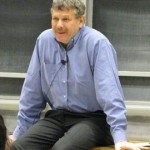 We increasingly incorporate technology into our work lives; LinkedIn, iPhones, MS Outlook all help us get more done, more quickly. As computers and the Internet help us manage more of our daily living, we think about what makes us essentially different from all the silicon.
We increasingly incorporate technology into our work lives; LinkedIn, iPhones, MS Outlook all help us get more done, more quickly. As computers and the Internet help us manage more of our daily living, we think about what makes us essentially different from all the silicon.
So we were heartened to read that Svante Pääbo, a prominent German evolutionary geneticist at the Max Planck Institute for Evolutionary Anthropology, is dedicating his life’s work to finding out what makes us essentially human. His approach? Sequencing the entire genome of the Neanderthal.
The human genome was sequenced in 2000, a significant feat in the history of biology. Still, Craig Venter and company had a lot of material to work with; humans are everywhere. Pääbo, however, is working with small fragments dating back 30,000 years. And that’s if the chip of bone or speck of skin is recent.
Amazingly, Pääbo is halfway through mapping the Neanderthal genome. Once it’s done, he’ll compare it bit by bit with the human genome, and see where the two diverge. It’s estimated that the two genomes vary by 4%; Pääbo is hot on the heels of that small, yet significant, percentage!
Yet he may have never progressed this far had he listened to some of his former colleagues. Indeed his career path is intriguing, as reported in a recent New Yorker profile by Elizabeth Kolbert:
When [Pääbo] was a teenager, his mother took him to visit the Pyramids, and he was entranced…
“I really wanted to discover mummies like Indiana Jones,” he said…
In the early nineteen-eighties, Pääbo was doing doctoral research on viruses when he once again began fantasizing about mummies. At least as far as he could tell, no one had ever tried to obtain DNA from an ancient corpse. It occurred to him that if this was possible, then a whole new way of studying history would open up.
Suspecting that his dissertation adviser would find the idea silly (or worse), Pääbo conducted his mummy research in secret, at night.
The results of his work were a hit!
Pääbo’s mummy paper became the cover article in Nature. It was also written up in the Times, which called his achievement “the most dramatic of a series of recent accomplishments using molecular biology.”Pääbo’s colleagues in Sweden, though, remained skeptical. They urged him to forget about shrivelled corpses and stick to viruses.
“Everybody told me that it was really stupid to leave that important area for something which looked like a hobby of some sort,” he said.
At this point, Pääbo went to work at the University of California at Berkeley with a team of like-minded scientists.
Note that in order to move forward, he had to pay more attention to his desire to learn, than to his nay-saying colleagues in Sweden. And temporarily, he went to great lengths to hide his work.
Ultimately, our protagonist accepted a full professorship in Germany, and eventually started the Neanderthal Genome Project, in which he’s currently involved.
Oh, and along the way he invented the field of paleogenetics.
How can you make great discoveries? Take Pääbo’s lead, and follow your bliss.
Image via




Sarah, thank you for a rolnesabae response. Bitch-ness abounds down here though always meant constructively.